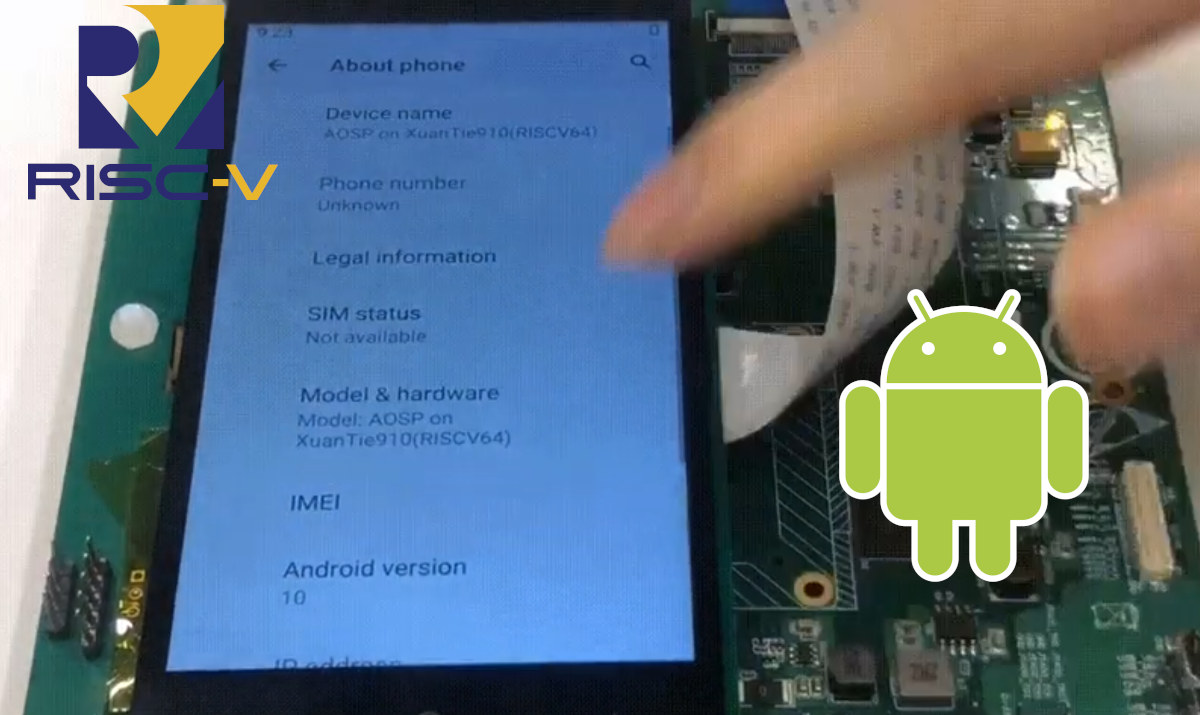RISC-V has made a lot of progress in just a few years, but for anything requiring 3D graphics acceleration, it’s not quite there yet. and we only expect RISC-V SoC with Imagination Technologies GPU to come out later this year on hardware such as BeagleV SBC.
An OS that will definitely require 3D graphics acceleration is Android, and work has already started since T-Head, a business entity of Alibaba Group specializing in semiconductor chips, has already ported Android 10 (AOSP) on RISC-V architecture with support for graphics and the touchscreen display.
The demo above runs on ICE EVB powered by a XuanTie C910 based high-performance SoC board developed by T-Head. Specifically, the ICE SoC integrates two XuanTie C910 cores (RV64) @ 1.2 GHz, one other XuanTie C910V core @ 1.2 GHz with vector extensions, a single-core 3D GPU core [Update: it’s a Vivante GC8000UL GPU], DDR4 memory support, a GMAC (Gigabit Ethernet) interface, as well as 4Kp60 HEVC/AVC/JPEG video decoding. The display resolution appears limited to 1920×1080 however.
You’ll find instructions to build Android on RISC-V by yourself on Github, but since AFAIK the board is not publicly available right now, it’s not possible to try it out unless you work for T-Head… That means Android capable RISC-V SBCs are probably coming this year, likely followed by RISC-V TV box a little later, and potentially RISC-V smartphones in a few years.
There’s similar information on T-Head website, plus an invitation to join the “Open Chip Community” group on DingTalk for people interested in the project.
Via Drew Fustini.

Jean-Luc started CNX Software in 2010 as a part-time endeavor, before quitting his job as a software engineering manager, and starting to write daily news, and reviews full time later in 2011.
Support CNX Software! Donate via cryptocurrencies, become a Patron on Patreon, or purchase goods on Amazon or Aliexpress. We also use affiliate links in articles to earn commissions if you make a purchase after clicking on those links.








Nice. Looking forward to seeing the first commercial RISC-V Android phone in a year or two.
“That means Android capable RISC-V SBCs are probably coming this year,”
Does that mean it will run Linux too? With GUI? If so: hacked together with binary blobs, or plain (mainstream?) Linux?
Vivante is already supported by Mesa via the etnaviv driver.
“BeagleV will be supported by mainline Linux and a Debian-based software image will be provided”. So Linux will be supported first, but if you’d like to get 3D graphics acceleration it will take longer as well.
I’d suspect RISC-V + Imagination PowerVR SoCs will work on Android first, with Linux support coming later (possibly with hack from Android drivers), but for RISC-V + Vivante SoCs like T-Head ICE may well support Android and Linux at about the same, as long as it’s not difficult to port etnaviv open-source driver from Arm to RISC-V.
As etnaviv is in vanilla mesa porting should be a minor issue, but well theory vs real life 🙂
On the picture of the XuanTie: “Extra CP910V @ 1.2GHz core with vector extension, up to 128bit” I would like to compare a today vector processors with GPGPU, capabilities. Vector processors was the power of the Cray computers or Cell architecture (this one has other limits in its processor architecture), and it could again be competitive. some interesting articles, show the principle and power of vector processors over SIMD. But in fact, it could be very usefull in today web application too, mainly on column oriented DB (Redshift, BigQuery,Snowflake, HBase) or compute RRDTool based data
https://medium.com/swlh/risc-v-vector-instructions-vs-arm-and-x86-asimd-8c9b17963a31
https://blog.aignacio.com/hwacha-vector-processor-for-risc-v/
Interesting artical, I had to look up process 28HPC+ meaning ref : https://www.synopsys.com/designware-ip/technical-bulletin/logic-library-capabilities.html
So I learned more too ?
does it have lte/telephony ?
The chip doesn’t, but the board might via an external module like it’s done on PinePhone smartphone.